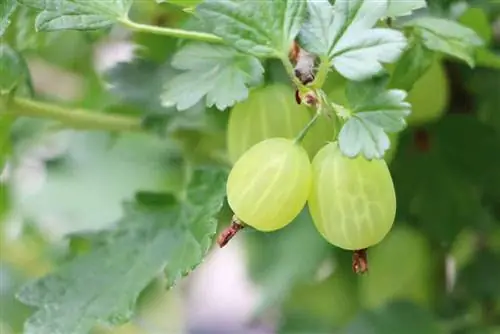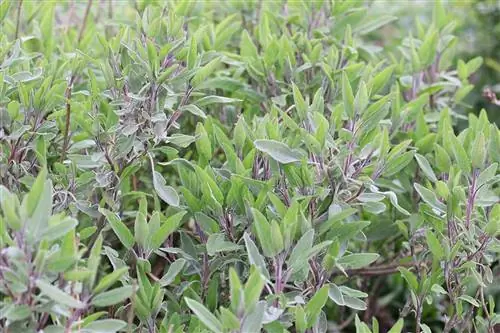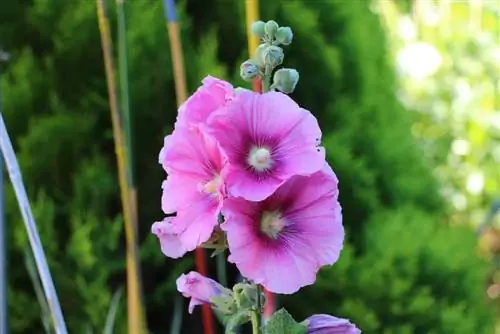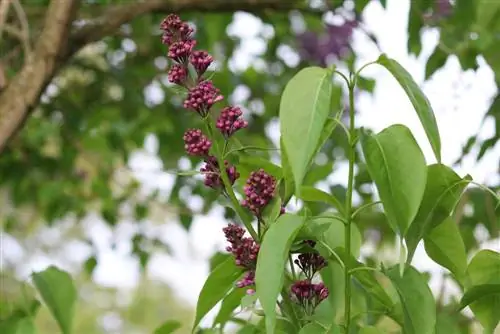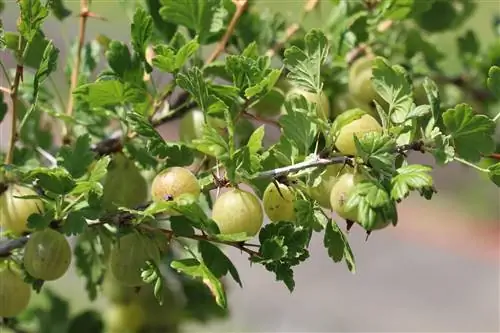- Author admin [email protected].
- Public 2023-12-17 03:39.
- Last modified 2025-06-01 06:48.
Experienced gooseberry gardeners advocate late winter as the best cutting date for several reasons. During the leafless period there is a clear view of the network of old and young tendrils. You can also see the positions of the thorns better. Nevertheless, summer pruning when a gooseberry is at an advanced age can be useful in order to give the young shoots more space for growth or to limit diseases. Therefore, the window of opportunity for professional pruning of gooseberries opens twice a year.
The ideal time
The following overview summarizes when you should use scissors:
- Education and maintenance cut: End of February to beginning of March
- Summer pruning: immediately after harvest
- Rejuvenation cut: in late winter
For winter pruning, please choose a frost-free day. Cutting measures below the freezing point impair wound healing and cause frost damage to the cuts. For summer pruning, you should ideally wait for a day with dry weather, as cutting into wet wood should be avoided.
Why pruning?
There is a world of difference between the fruit quality of uncut and cut gooseberries. What is characteristic of the berry bush is that it develops its optimal yield on the one- and two-year-old shoots. In contrast, from the third or fourth year onwards, only fruits of inferior quality grow on older canes.
Regular cutting clears the way for the growth of young shoots, which will give you juicy, sweet gooseberry enjoyment in premium quality for one to two years. At the same time, you bring order to the thorny bush, which makes harvesting much easier. Last but not least, you can keep the spread of mildew under control with annual pruning measures.
Educational Cut
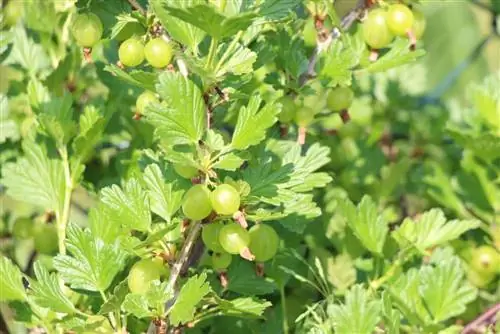
On a freshly planted gooseberry bush, the pruning measures in the first two years aim to produce fruitful cultivation. The aim is to have a basic structure of 4 to 6 strong canes on which the fruit thrives. In their first year of growth, gooseberries do not yet have the robust frost resistance of an adult plant. The best time for pruning is therefore during the first two weeks of March, when severe frosts are no longer expected. How to cut correctly:
- Select the 4, 5 or 6 strongest specimens from all shoots
- Cut these back by a third or half
- Cut all other rods close to the ground
Please make sure that no stubs are left behind when removing unnecessary shoots. Branch stubs are a breeding ground for fungal spores and other pathogens. By dusting the cuts with rock dust or charcoal ash, you disinfect the danger areas naturally.
Follow this pattern again the following year. If your gooseberries prove to be sufficiently vigorous, you can increase the number of fruit canes to 8 to 10 in the second year. Cut off excess and weak shoots at the base. This completes the upbringing and leads to the maintenance phase.
When exactly the time comes depends on the variety, quality of location and weather conditions. Experience has shown that education does not take more than three years. From this point onwards at the earliest, supplementary summer pruning proves to be advantageous because a stock of worn-out, old shoots is increasingly accumulating.
Conservation cut
On gooseberries, pruning training results in continuous maintenance with uncomplicated pruning. If you act according to the motto 'New replaces old', you can't go wrong. How to proceed professionally:
- Thin out dead wood and weak shoots
- Prune inward-facing branches or remove them completely
- Cut old rods three years old and older close to the ground
- At branches that are too close, divert the older shoot to the younger one
- Black discolored tips on this year's and last year's wood cut into the he althy area
- Do not leave more than 4 to a maximum of 10 fruit canes
- Short fruit canes that are too long by a third

You can use visual characteristics to distinguish between old and young shoots on gooseberry bushes. An old branch shows dark, richly branched wood that is often covered with moss. You can recognize a fresh shoot by its light-colored wood and straight, unbranched growth. Please note that not every older shoot has to be completely removed. If you lack enough one- and two-year-old young shoots in an unfavorable year, shorten a three- or four-year-old branch. Cut this back to two or three eyes. Young, productive wood will sprout here until next year.
You can optionally do the maintenance cut in one go at the end of February/beginning of March. A step-by-step approach is more beneficial for your gooseberries. If you thin out the bush in the summer after the harvest, you will promote the growth of young shoots. Because summer pruning optimizes access to light, the one- and two-year-old canes develop faster and stronger until winter than if they were in the shade of worn branches.
Tip:
Don't you want to rely on visual characteristics to distinguish old from young shoots? Then simply mark the rods with small rings in different colors.
Rejuvenate the gooseberry bush
Neglected gooseberry bushes present themselves as a tangled web of many old and a few young branches. In addition, the quality of the gooseberries leaves a lot to be desired because the fruits are small and sour. After a courageous rejuvenation cut, an senile shrub will regenerate and grow with new vigor. The cut is incredibly simple. Select the three promising shoots as a basic structure. Cut off all other branches at ground level.
Then fertilize generously with compost and horn shavings or berry fertilizer. If the effort is rewarded with a summer shoot, trim the rejuvenated gooseberry bush from now on according to these instructions. However, if there is no reaction, the plant should be completely replaced.
Note:
Did you know that you can use pruning shears to reduce painful scratches caused by the sharp spines to a minimum? Thanks to the longer handles, you can keep a sufficient distance from your defensive gooseberries when cutting the shoots. The sensitivity for professional cutting remains intact.
Training gooseberries into standard stems
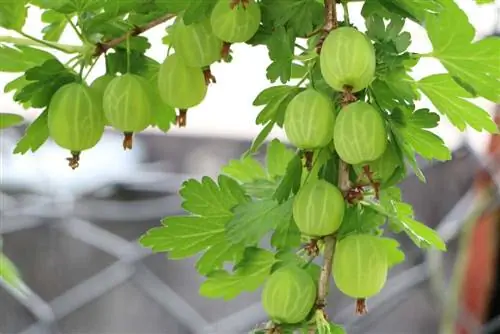
As a standard gooseberry is decorative and less prickly when harvested. In beds and containers, the classic fruit trees with trunk and crown do not take up as much space as they do as a large shrub. Here we will explain step by step how you can train a young gooseberry plant to become a standard plant:
- Choose the most powerful shoot for the future trunk
- Tie this central shoot to a support rod with soft binding material
- Cut off all other branches at the base
In the following years you will continuously guide the central shoot upwards on the rod. Consistently remove all vertically growing shoots because they compete with the trunk for nutrients and light. The growth in thickness of the central shoot is promoted by regularly cutting off the side shoots. Continue this cut and the direction on the pole until the trunk has reached the desired height. However, only use the scissors when the tip is three to four leaves above the desired position of the crown. By cutting the tip of the trunk, you start the branching to the crown.
A shapely and high-yielding crown consists of 4 to 6 shoots in the first year. Prune these by a third or half so that they bear the first fruit in summer. Cut off all other side shoots along the trunk. Depending on the carrying capacity of the central shoot, the crown can be enlarged in subsequent years to up to 10 one- and two-year-old canes.
Shaping and maintenance pruning on the standard trunk
To ensure that a gooseberry as a standard tree maintains its shapely and productive crown, shape and maintenance pruning is part of the care program every year. When shaping, please note that gooseberry standard stems are not suitable for a crown with elegantly hanging branches. If shoots lean to the ground, this is an unmistakable sign that their productivity is noticeably decreasing. The following overview summarizes when and how to properly cut gooseberries on the standard stem:
- In early spring, shorten drooping, worn branches by half
- Cut away old shoots with dark, mossy wood at the base
- Standing, strong young wood from the last two years should not be cut back or cut back by a maximum of a third
- Remove side shoots below the crown from the trunk
- Cut off steeply upward competing shoots close to the ground
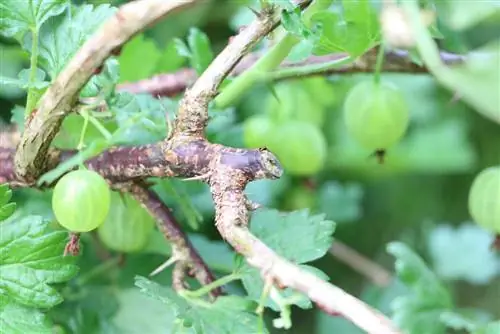
The result of the professional maintenance pruning is a light-flooded crown with strong one- and two-year-old canes. You can cut back older branches down to two leaf nodes so that fresh wood sprouts here. This always makes sense if you want a denser crown and not enough young shoots are growing. Please do not remove the support rod until the trunk is stable enough to support the crown.
Tip:
The red gooseberry 'Larell' is ideal for gardening with your children in the family garden. The joy of gardening is not affected by painful scratches on the skin when pruning the tendrils because this variety does not have the dreaded thorns.
Special case of columnar fruit
- Instructions from A for construction to Z for cutting back -
Pillar fruit is the ideal solution for growing gooseberries in a small garden. This variant of cultivation grows slimmer than a bush. In contrast to the standard tree, which only produces fruit in the crown, the entire height of the columnar fruit is used for the growth of fruit canes. To train a young gooseberry bush to become a columnar fruit, proceed as follows when pruning:
- Fix the central shoot to a support rod with ties
- Cut off all other basal shoots
- Do not shorten side shoots in March of the first year or only shorten the tips
From the second year onwards, cut the worn canes back to cones in late winter. To do this, position the scissors so that only two eyes remain on the branch. Do not cut last year's branches because the best fruit will grow here this year. After harvesting, thin out the gooseberry column thoroughly. Take this opportunity to remove any unnecessary ground shoots so that your gooseberries maintain their slender columnar shape.

